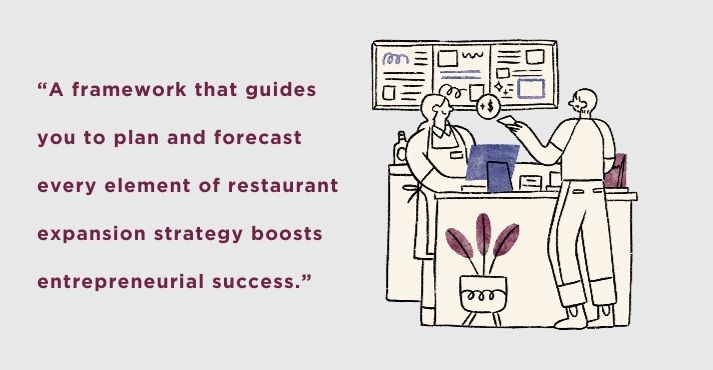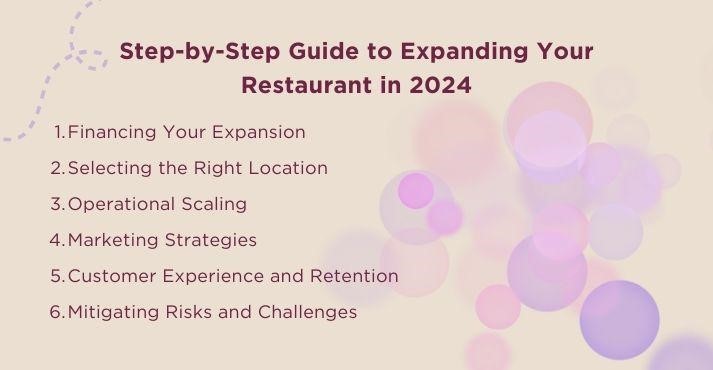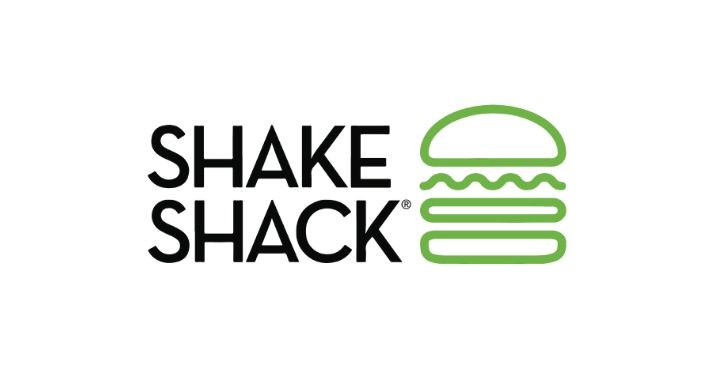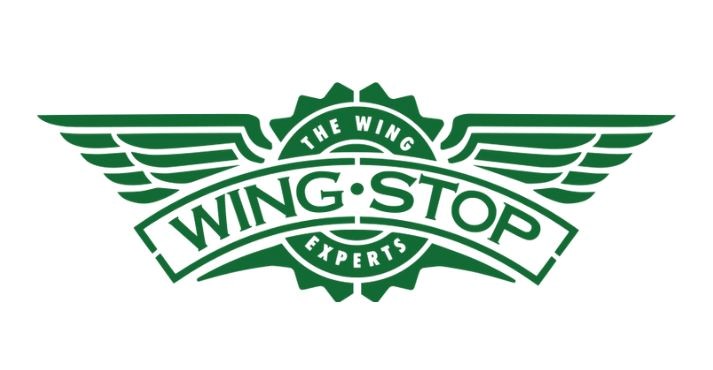Your restaurant is doing great in sales and revenue, the staff is happy, and restaurant sales are booming.
So, you’re wondering where to go from here?
Restaurant expansion and culinary growth could be in the cards. There are several ways to begin your restaurant development and address expansion challenges with a well-thought-out plan backed by extensive research and analysis, ensuring effective execution.
So, what are the key steps to take during the exciting process of expanding your restaurant business? Let’s have a look at each step in detail
Planning for Growth

Planning is an essential element when it comes to expanding restaurants. Growth isn’t always linear or looks the same for every business. Growth is the process of expanding or improving your hotel operations management.
Most restaurant growth doesn’t just happen—there’s action and strategy behind it. Consider the following aspects when planning restaurant growth.
Assessing Readiness
Get, set, grow. Are you ready for growth?
While preparing for restaurant growth, you need to analyze your current model and check whether it should be replicated or tweaked before you start your restaurant expansion.
Here are some key factors to consider when assessing expansion readiness:
- Market demand assessment: Evaluate customer needs and trends to ensure a viable market for expansion, aligning with potential demand.
- Resource analysis: Analyze available assets and capabilities, ensuring adequate resources for successful expansion without compromising existing operations.
- Operational efficiency: Streamline processes and workflows for optimal performance, enhancing the ability to scale operations smoothly during expansion efforts.
- Financial stability: Assess fiscal health, ensuring the financial strength required to sustain expansion initiatives and manage potential challenges.
- Budget estimates: Develop accurate cost projections, including all expansion aspects, to facilitate informed decision-making and resource allocation for successful implementation.
- Project timelines: Establish realistic schedules for each expansion phase, ensuring timely execution and minimizing disruptions to existing operations.
Operational readiness for expansion involves optimizing processes, securing resources, and aligning capabilities with market demands to ensure a seamless expansion.
Market Research and Trends
Before expanding your restaurant business, carefully consider market research and trends. To gain market understanding, you need to focus on the following three aspects:
- Industry – The industry as a whole
- Competition – The competition your restaurant will face
- Target Audience – The right audience for your restaurant
Moreover, analyzing trends before restaurant expansion helps you identify consumer preferences, market demands, culinary trends, and emerging patterns.
This insight guides menu planning, marketing strategies, and location selection, ensuring the restaurant expansion aligns with current and future trends.
Here are some of the key trends and factors to consider:
- Identifying customer preferences
- Strategic location analysis
- Uncovering culinary trends
- Technology integration
- Personalization and customization
By industry trends, you can identify opportunities that your competitors may have missed and find unique ways to meet the changing needs of your customers.
Developing a Growth Strategy
Restaurants are a massive, growing industry.
It may seem like a no-brainer, but developing a growth strategy requires a lot of planning to attract and retain customers, employ marketing strategies, and get new diners in the door.
Traditionally, most restaurants select one of three courses for expansion:
- Opening up a new location
- Opening up multiple locations
- Franchising the brand.
If you want to grow, you have to set goals. Otherwise, how will you measure your success? But what aspects does growth strategy include?
Creating a comprehensive growth strategy is essential for identifying uncertainties, optimizing resource allocation, and aligning efforts to achieve results, ensuring a systematic approach for successful expansion.
- Target audience identification
- Action plan (goals)
- Operational efficiency
- Location selection
- Menu diversification
- Branding
- Financial planning
A growth strategy provides a roadmap to get your restaurant business from where it is now to where it wants to be.
Step-by-Step Guide to Expanding Your Restaurant in 2024

If everything goes well, why not duplicate success and grow your profits? As a hotelier, the more preparation and research you put into expanding your restaurant business, the more successful you’ll be.
As with any other industry, the restaurant industry has also reached a state where it needs expansion and takes on new challenges for its continuous growth.
Read on for our actionable, step-by-step guide on how to expand your restaurant business.
- Financing Your Expansion
- Selecting the Right Location
- Operational Scaling
- Marketing Strategies for Expanding Your Restaurant Business
- Customer Experience and Retention
- Mitigating Risks and Challenges
Financing Your Expansion

The key to financing a restaurant expansion is keeping expenses as low as possible. Before deciding how to finance your expansion, determine how much money you need to open a restaurant at a new location and regular expenses.
Evaluate the expansion cost, internal funds, bank loan requirements, and strategies to implement financial controls.
Budgeting and Financial Planning
Regarding long-term restaurant business success, preparation is the name of the game. The key to winning this game is developing a solid financial strategy, meeting short- and long-term goals, and finding where to utilize financial resources.
It typically involves:
- Financial planning provides a framework for a restaurant’s objectives — typically for the next 3 to 5 years.
- Budgeting details how the plan will be carried out monthly and covers revenue, expenses, potential cash flow, and debt reduction.
- Forecasting takes historical data and current market conditions and predicts how much revenue a restaurant can generate.
When done correctly, budgeting and financial planning can help you stay on track and focus on the goals and objectives. Your budget defines your limits, and your financial forecast outlines possibilities within those constraints.
A budget provides a framework for managing financial decisions within your control, offering guidance for effective financial planning.
Here are some effective budgeting strategies for restaurant expansion:
- Use historical data: Analyze past financial records to identify spending patterns, enabling informed projections and realistic budgeting.
- Consider contingency: Allocate funds for unforeseen expenses, providing a financial buffer to address unexpected challenges.
- Negotiate supplier costs: Negotiate favorable terms with suppliers to secure cost-efficient agreements, minimize expenses, and enhance the financial feasibility of the expansion.
- Optimize staffing levels: Evaluate staffing needs based on projected demand, ensuring an optimal balance between service quality and labor costs.
- Implement cost controls: Enforce strict cost management measures, scrutinize expenditures, and implement policies to control and reduce unnecessary costs.
- Leverage technology: Embrace technology to enhance operational efficiency, streamline processes, and reduce manual errors.
- Monitor cash flow: Keep a close eye on cash flow to ensure that income and expenses align, facilitating financial stability and providing insights for strategic decision-making.
- Regularly Review and Adjust: Periodically assess budget performance, identifying areas of improvement and adjusting financial plans.
Moreover, funding sources for restaurant expansion are essential to ensure adequate capital for growth, cover costs, and mitigate financial risks, ensuring a successful expansion.
Consider these potential sources for securing funds for restaurant growth:
- Loans: Securing bank loans involves borrowing a predetermined amount with interest, providing immediate capital for expansion. It requires a solid credit history and a repayment plan.
- Investors: Attracting investors involves selling equity in the restaurant in exchange for capital. Investors provide funding in return for a share of ownership and potential profits.
- Grants are non-repayable funding sources, often awarded based on specific criteria, such as promoting community development or innovation in the restaurant industry.
Cost Control Measures
Managing costs during restaurant expansion is essential to maintain financial health and efficient operational practices. Cost control measures refer to monitoring and managing expenditures to ensure they stay on track and within budget.
When streamlining expansion costs, consider the following cost control measures:
- Implementing efficient operational practices: Streamline daily operations by optimizing workflows, reducing wait times, and enhancing efficiency.
- Energy efficiency measures: Implement energy-saving technologies and practices to reduce utility costs during expansion. It includes using energy-efficient appliances and optimizing lighting and heating systems.
- Staff training for efficiency: Invest in training staff to enhance productivity and operational efficiency, minimizing labor costs and ensuring that employees are well-equipped to handle increased demand during expansion.
- Technology Integration: Incorporate advanced point-of-sale systems and restaurant management software to streamline operations, improve order accuracy, and enhance overall efficiency, reducing manual errors and saving costs in the long run.
- Negotiation strategies: Employ effective negotiation tactics when dealing with suppliers and vendors to secure favorable terms, lower prices, and discounts, ultimately reducing costs and maximizing budget efficiency during restaurant expansion.
- Inventory management: Implement a systematic approach to control stock levels, minimizing waste, and avoiding overstocking. Efficient inventory management ensures optimal resource utilization and reduces carrying costs.
There are many different ways restaurants can control costs. For example, effective cost control can prevent overspending, ensure funds are appropriately allocated, enable the restaurant to stay within budget, avoid financial strain, and optimize operational efficiency.
Selecting the Right Location for Your New Restaurant

Choosing the right location for your restaurant is the most critical decision. Several factors go into choosing the location for your new restaurant, from the type of target audience you want to attract to competition in the area to the price per square foot for a particular area.
That’s not easy, though, since thousands of restaurants fail yearly. Therefore, a restaurant location analysis is essential in a hotel marketing plan.
Location Assessment
Your restaurant’s location can be as crucial to your success as your menu, marketing, or guest experience. Your restaurant’s location can help you attract customers.
A restaurant right at the front of the building has maximum visibility and generates the highest footfalls compared to the other areas.
For example, a prominent location surrounded by boutiques and entertainment venues is a built-in marketing tool. The bustling foot traffic and nearby attractions increase visibility and exposure.
Before doing anything else for your restaurant location, consider the following factors.
- Demographic Analysis
Start with a thorough demographic analysis, including
- Population density
- Age distribution
- Income levels
- Spending patterns
- Competitors in the area
For example, suppose you want to run a more modern eatery that attracts younger people. In that case, you may choose an entirely different location than a cozy roadside restaurant that caters to couples.
- Competitive Location Evaluation
Perform a comprehensive competition analysis by identifying existing restaurants in the area. Evaluate their menu offerings, pricing strategies, and market positioning. This analysis helps identify gaps in the market and potential niches for the new restaurant.
- Brand Alignment
Aligning location with brand identity is essential to assess whether the ambiance and atmosphere complement the brand image. For example, a trendy urban location may suit a modern and upscale restaurant, while a more casual setting may be preferable for a family-oriented establishment.
- Accessibility
Consider accessibility and foot traffic to measure the potential customer flow. Proximity to complementary businesses or attractions can also enhance the restaurant’s visibility and draw.
Moreover, choosing the optimal restaurant location is essential for revenue generation as it determines accessibility, visibility, and demographic alignment. A strategically located restaurant can attract a more extensive customer base, enhance brand visibility, and capitalize on local foot traffic, increasing sales and revenue.
Regulatory Compliance
Understanding and ensuring regulatory compliance with local regulations, permits, and zoning laws is essential when selecting a new restaurant location. Failure to comply can lead to legal issues, fines, or even closure.
Zoning laws for expansion define the type of businesses allowed in specific areas, influencing the restaurant’s feasibility in a chosen location. Local authorities enforce these rules to ensure public safety, community welfare, and orderly development.
Zoning laws
When navigating zoning laws for the expansion of your restaurant, consider the following:
- Business license: Ensure compliance with local zoning and licensing regulations by acquiring the licenses and permits to operate your restaurant within the legal framework of your locality.
- Health Department permit: Maintain a health department permit to meet and uphold local sanitation and safety standards, ensuring the restaurant operates by health regulations.
- Alcohol beverage license: If your establishment serves alcohol, secure the necessary liquor license and strictly comply with the regulations governing alcohol sales and service. For instance, it is mandatory to refrain from serving alcohol to individuals under the legal drinking age of 21.
Licensing and permits
To maintain regulatory compliance, check that all necessary licenses and permits haven’t expired. Standard licenses and permits you may need include:
- Business License
- food and beverage establishment permit
- Alcohol license (if you serve alcohol)
- Health department permit
- Fire department permit
Adhering to the laws and regulations impacting your restaurant isn’t optional; it’s imperative. Despite the challenges of maintaining compliance, it is a safeguard for your staff.
Non-compliance, on the other hand, poses severe challenges. Violations may result in legal troubles, financial penalties, and the potential shutdown of your restaurant.
Operational Scaling

Operational scaling in a restaurant refers to optimizing and expanding internal processes to accommodate increased demand and business growth.
It involves refining workflows, enhancing kitchen and service operations efficiency, and implementing systems that can handle more customers.
Operational scaling allows restaurants to maintain quality, meet customer expectations, and achieve financial sustainability as they grow and serve larger audiences.
Staffing and Training
Scaling restaurant staff during expansion presents challenges such as maintaining consistent service quality and culture. Recruitment becomes essential, requiring thorough employee training to align new hires with existing standards.
Balancing labor costs and scheduling efficiency becomes challenging, necessitating strategic approaches to ensure an effective workforce.
- Recruitment strategies
Some of the critical recruitment strategies include:
- Online job boards
- Social media recruitment
- Employee referral programs
- Collaborations with culinary schools
- Local community partnerships
- Networking platforms
Identify candidates aligned with your restaurant’s values. Utilize diverse recruitment channels and conduct thorough interviews to assess skills and cultural fit, ensuring a solid team foundation.
- Staff scaling and training
Implement a comprehensive and effective employee training program covering job responsibilities, customer service, and company culture.
Ultimately, a strong restaurant training program:
- raises the skill level of every employee in the restaurant
- boosts staff morale and motivation
- helps build employee confidence
- improves overall performance
Creates a continuous learning and mentorship program to enhance staff skills and satisfaction.
- Employee retention
Prioritize employee well-being, offer competitive benefits, and recognize achievements. Maintain open communication channels, address concerns promptly, and create a positive work environment to enhance employee retention during expansion.
Employee retention must focus on the 3 R’s:
- Respect
- Recognition
- Reward
By focusing on respect, recognition, and reward, businesses can create a nurturing environment where restaurant staff feel valued and motivated.
Technology Integration
Digitalizing restaurant operations means transforming traditional, manual processes into digital formats through technology. It includes implementing software, tools, and automated systems to streamline tasks, enhance efficiency, and improve management and decision-making in various business operations.
Digital management and operational technology have allowed many restaurants to enhance efficiency and meet consumer demands in an increasingly digital age.
Here are some essential tech solutions for the expansion of restaurant operations:
- Point-of-Sale (POS) Systems
- Inventory Management Software
- Reservation and Booking Systems
- Online Ordering Platforms
- Customer Relationship Management (CRM) Software
- Staff Scheduling Software
- Table Management Systems
- Kitchen Display Systems (KDS)
- Contactless Payment Solutions
- Analytics and Reporting Tools
Moreover, technology integration helps in communication, staff scheduling, and customer engagement, contributing to operational effectiveness and success in a larger-scale restaurant operation.
Marketing Strategies for Expanding Your Restaurant Business

From leveraging your restaurant’s unique selling point to establishing an online presence through social media and content, there are many ways to market your restaurant business.
With the right restaurant marketing strategies, you can fill your tables, increase your customer base, and drive revenue. It’s the strategy behind engaging with your customers across multiple channels to reach your audience.
Pre-launch Marketing
Pre-launch marketing refers to a restaurant’s strategic activities and campaigns before its official launch. This phase aims to generate awareness, build anticipation, and create buzz among the target audience.
Pre-launch marketing efforts often include teaser campaigns, social media promotion, exclusive previews, and other tactics to engage potential customers and create a sense of excitement leading up to the official launch.
Here’s your actionable checklist for building buzz for the restaurant launch:
- Develop Website
Create a user-friendly website showcasing the restaurant’s concept, menu, and ambiance. Include an enticing coming soon section to capture interest and encourage visitors to subscribe for updates.
- Run Social Media Ads
Utilize targeted social media advertising to reach potential customers, teasing the upcoming restaurant launch with visually appealing content and enticing promotions.
- Campaign Teasers
Deploy teaser campaigns on various channels, offering glimpses of the restaurant’s unique features, signature dishes, and dining experience to build anticipation and curiosity.
- Collaborative Marketing
Partner with local influencers, food bloggers, or businesses to co-promote the restaurant, leveraging their audience to increase awareness and generate buzz before the launch.
- Optimize Google My Business
Ensure the restaurant’s Google My Business profile is complete and engaging, providing accurate information, high-quality images, and reviews to enhance online visibility and attract local patrons.
- Restaurant Branding
Develop a cohesive and memorable hotel branding strategy that reflects the restaurant’s identity. Consistent branding across all pre-launch materials creates brand recognition and loyalty.
- Email Marketing Campaign
Build an email list by encouraging website visitors to subscribe and sending them discount vouchers, newsletters, and promotion information.
Localized Marketing
Localized marketing is a powerful strategy to build a community around your restaurant brand. It refers to marketing strategies tailored to a specific geographic area or community. It considers local culture, language, customs, and consumer behaviors.
When creating a localized marketing campaign for your restaurant, you must manage the following aspects:
- Adapting marketing to local tastes: Tailor marketing strategies to resonate with local preferences, emphasizing menu highlights that appeal to the community’s culinary preferences.
- Cultural Alignment: Align marketing messages and themes with the local culture, showcasing an understanding and appreciation for the community’s traditions, values, and lifestyle.
- Community Engagement: Actively engage with the local community through events, sponsorships, and partnerships.
- Work with Local Suppliers: Develop relationships with nearby suppliers to source fresh, local ingredients. Highlighting these partnerships in marketing materials, showcasing the commitment to support the local economy.
Customer Experience and Retention

A great customer experience can make all the difference. Acquiring new customers is essential, but retaining existing ones is crucial.
To truly understand the customer experience, you need to identify their needs, wants, and expectations and make sure that your restaurant brand delivers on its promises.
The experience you create for your customer, good or bad, can define your retention rate. When customers consistently enjoy positive experiences with a brand, their inclination to explore alternatives diminishes.
Maintaining Quality
To ensure consistent service and culinary excellence during expansion, prioritize quality maintenance as a core entity. Implement culinary quality Control as a Local Semantic Index (LSI) to monitor and uphold high food standards. Leverage technological solutions for streamlined operations and real-time monitoring. These strategic measures for quality maintenance will ensure your restaurant delivers a consistent customer experience.
Here’s how you can maintain service and food quality during expansion:
- Standardized processes across all locations to maintain consistency in service and food preparation methods.
- Comprehensive training programs to ensure staff members are well-versed in the brand’s service standards and culinary quality expectations.
- Quality audits and assessments regularly to identify and address any deviations from established service and food quality standards.
- Integrate technology solutions for order processing, inventory management, and quality monitoring, ensuring real-time insights.
- Customer feedback mechanisms gather insights into service and food experiences, enabling prompt adjustments and improvements.
- Maintain strong partnerships with reliable suppliers to ensure consistent access to high-quality ingredients.
Loyalty Programs and Customer Engagement
The key to successful customer engagement is incentivizing customers to remain loyal to your brand. A loyalty program is a perfect way to do this, as it enhances customer engagement, ensuring customers keep coming back and making purchases from you to earn rewards.
When building customer loyalty, consider these strategies to enhance customer retention and drive engagement:
- Tiered reward system: Establish a tiered loyalty program offering escalating benefits based on customer spending.
- Personalized offers: Utilize customer data to create personalized offers and promotions tailored to individual preferences.
- Mobile app integration: Implement a user-friendly mobile app that not only houses the loyalty program but also provides a convenient platform for customers to track rewards, receive exclusive deals, and engage with the brand.
- Surprise rewards and bonuses: Incorporate occasional surprises, such as free items, birthday treats, or exclusive event access.
- Feedback mechanism: Encourage customer feedback by offering additional rewards or discounts for reviews or surveys.
Ultimately, the benefits of customer loyalty programs are many, including increased revenue and profitability to improved brand loyalty and customer retention.
Mitigating Risks and Challenges

Once you know the in and out-expansion plan, you must focus on crisis-ready expansion, mitigating risks and challenges for long-term success. Proactive risk management helps anticipate potential issues, ranging from operational to financial and market-related challenges.
Addressing these risks ensures a smoother expansion process, minimizing disruptions and protecting the restaurant’s reputation. Effective mitigation strategies enhance adaptability and resilience, resulting in sustainable growth.
A restaurant’s potential risks and challenges during expansion:
- Operational inefficiencies: Maintaining consistent operations across multiple locations.
- Supply chain disruptions: Potential disruptions in the supply chain affecting ingredient availability.
- Market saturation: Risks associated with entering a saturated market with increased competition.
- Regulatory compliance: Challenges in adhering to diverse local regulations and licensing requirements.
- Financial strain: Potential financial strain due to increased overhead costs and initial investment.
- Customer adaptation: Risks related to customer adaptation and acceptance of the brand in new locations.
Contingency Planning
Contingency planning is imperative during restaurant expansion to address unforeseen challenges. It ensures preparedness for unexpected events, such as market fluctuations or operational issues.
The restaurant can respond promptly, minimize disruptions, and maintain operational stability by identifying potential risks and formulating strategies in advance.
Contingency planning enhances adaptability, enabling the business to navigate uncertainties, protect investments, and sustain growth during expansion.
Here’s a 5 step contingency plan for navigating restaurant risks:
- Risk assessment: Identify potential risks and challenges during restaurant expansion, encompassing operational, financial, and external factors.
- Impact assessment: Evaluate the potential impact of each identified risk on various aspects of the expansion, including finances, operations, and customer experience.
- Formulate response strategies: Develop proactive strategies and action plans to address and mitigate the identified risks, outlining specific steps to be taken if each risk materializes.
- Resource allocation: Allocate necessary resources, including finances and personnel, to implement the contingency plans effectively, ensuring readiness to respond to unforeseen challenges.
- Regular review and update: Periodically review and update the contingency plans, considering changes in the business environment, market dynamics, crisis management, adaptability strategies, and internal factors to maintain relevance and effectiveness over time.
Learning from Industry Case Studies
Learning from industry case studies when expanding a restaurant business is essential for informed decision-making and avoiding pitfalls. Analyzing successful and unsuccessful expansions provides valuable insights into practical strategies and potential challenges.
Case studies offer real-world examples, shedding light on market dynamics, industry insights, operational nuances, and consumer behavior. These success stories enable restaurateurs to adapt their approach, optimize expansion plans, and implement proven practices.
Learning from the experiences of others enhances strategic thinking, helps anticipate potential risks, and ensures a more calculated and successful restaurant expansion, ultimately contributing to sustained growth and profitability in a competitive industry.
Here are some examples of successful restaurant expansion that serve as the best expansion lessons for restaurateurs:
Shake Shack

The story of Shake Shack, a small hot dog stand operating out of Madison Square Park in New York City in 2001, eventually grew into a gourmet fast-casual restaurant with more than 377 domestic and international locations.
Five lessons learned from Shake Shack’s growth and expansion strategy are:
- Don’t underestimate small beginnings
- Find the white space
- Serve the local community
- Go slow with a plan
- Strategic employee management
Wingstop

Wingstop is an American international chain of restaurants that primarily sells chicken wings. The restaurant chain was founded in 1994 in Garland, Texas, and began offering franchises in 1997. They adopted a franchising strategy to expand their restaurant business.
Lessons learned from Wingstop’s expansion strategy are
- Innovating while staying true to the brand
- Using technology and adding value
- Strategic franchisee partnerships
Conclusion
There’s no one-size-fits-all solution for expanding a restaurant business. Ensure you are ready for restaurant expansion behind the scenes but have a well-thought-out roadmap to track the progress.
Market research, demographic analysis, and learning from industry case studies provide a solid foundation. Mitigating risks through contingency planning is essential, ensuring adaptability to unforeseen challenges.
Utilizing technology, personalized customer engagement, and loyalty programs enhance the customer experience and brand loyalty. Collaborating with local suppliers and creating a cohesive brand culture contribute to consistent quality.
Operational scaling, efficient staff management, and compliance with local regulations are integral for successful expansion. By incorporating these multifaceted strategies, restaurateurs can successfully expand their business.








